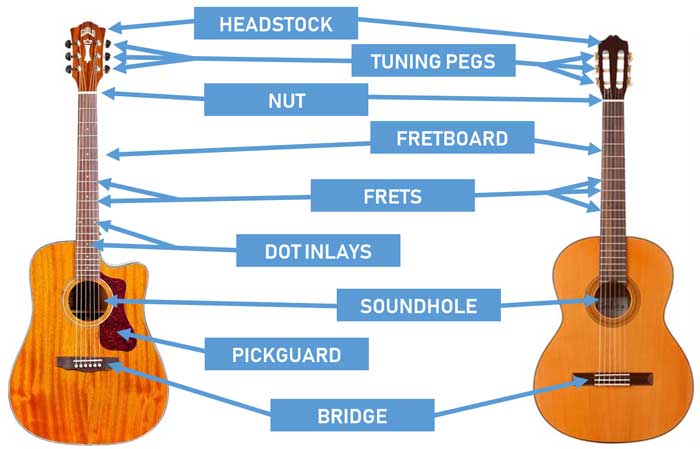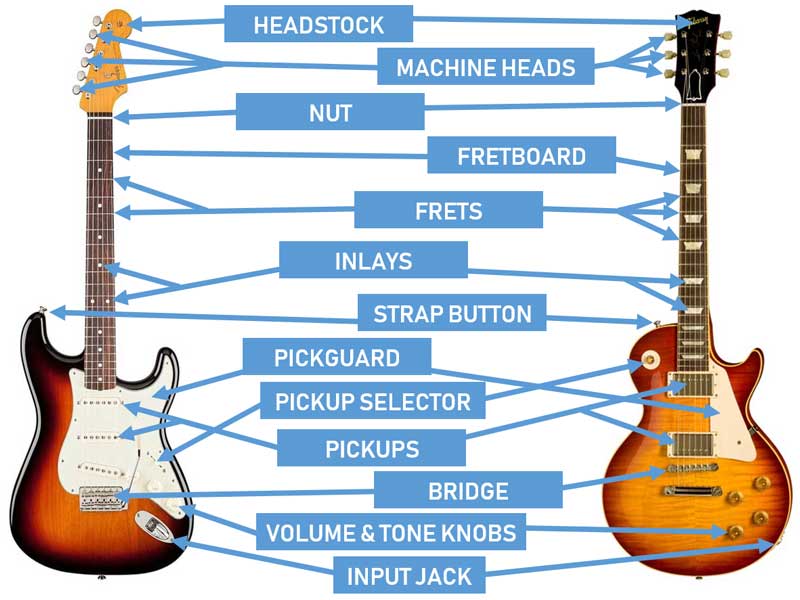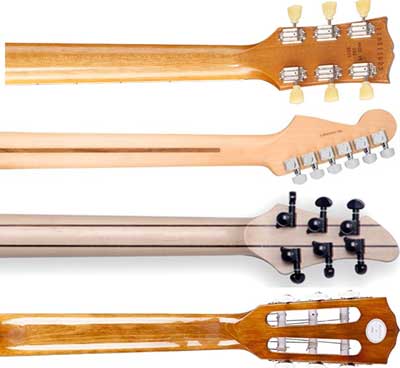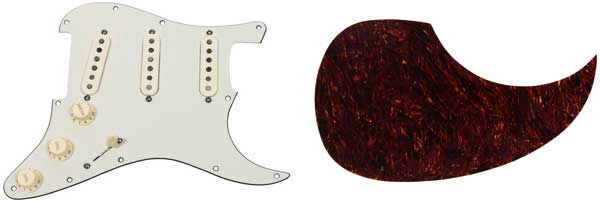Learning the parts of the guitar for both acoustic and electric guitars is important for every guitarist.
If you go to a store looking at buying a guitar, you’re going to hear a lot of part names. If you don’t know what some of those part names are, it will be hard for you to pick the right guitar for your needs.
In this guide you will learn all the important guitar part names, what they look like, what they do, and different variations for each part.
By the end of this guide, you will be able to talk to any guitarist and fully understand any guitar parts they mention.
Check out this guide to learn about the different types of guitars you can buy. The guide explains the differences between different types of guitars, what styles of music you can play on each type, and whether they’re suitable for beginners.
Main Parts of the Guitar
The below diagram shows the main parts for a range of both acoustic and electric guitars.

While all of the above guitars have different parts, design, and features, the main parts are the same.
All of the above guitars have three main parts:
- The head of the guitar shown in green
- The neck of the guitar shown in red
- The body of the guitar shown in blue
As you can see, there’s a lot of differences between the above guitars. While all have a head, neck, and body, the shape, features, and design are all different across the guitars. We will dig deeper into each part later on. The main point to remember is that all guitars start out with these main parts.
Acoustic Guitar Parts Diagram
The below diagram shows two different acoustic guitars with the parts labeled. The guitar on the left is a steel string acoustic and the guitar on the right is a nylon string acoustic.

While the two types of acoustic guitars are very different in how they sound and play, many of the parts are similar. In the above diagram, the shape of the body is different. The steel-string acoustic has a cutaway to give better access to the upper frets.
The steel-string acoustic has dot inlays on the fingerboard (also called fretboard) to mark out important fret positions. While the nylon string acoustic doesn’t have dot inlays, it does have markers on the side of the neck which is only visible from the guitarist’s view. Most guitars have a combination of markers on the side of the neck and on the fretboard.
Find out what the dot markers and inlays mean and how to use them in this guide.
Electric Guitar Parts Diagram
The below diagram shows two different electric guitars and their parts. The electric guitar on the left is a Fender Stratocaster and the guitar on the right is a Gibson Les Paul. These are two very popular guitar models, but there are plenty of different variations of electric guitar, all with different parts.

There are more parts to remember on electric guitars because of the electronics used and different features not available on acoustic guitars.
For example, both of the above guitars have pickups in between the fretboard and the bridge. The strat on the left has three single-coil pickups and the Les Paul on the right has two humbuckers. Single-coil pickups and humbuckers are the two most common types of pickups you will see, but there are other types as well.
What makes electric guitars confusing at times is the number of different parts available. If you compare the bridges on both of the above guitars, you will see they’re completely different from each other. The strat has a tremolo bridge with a tremolo arm (also called whammy bar) attached. The Les Paul uses a very different type of bridge and doesn’t have a tremolo bar. The different types of bridges available for electric guitars are covered later as well as why guitarists use different bridges.
Guitar Parts: Head or Headstock
With the exception of ‘headless’ guitars, all guitars have a headstock. This is where the strings connect and where you tune the strings up. The below examples show how different headstocks can be across different guitars:

The two most common headstock layouts are 3+3 style where there are three tuners per side and 6 in line which has all six tuners on one side. There are other layouts as seen above.
Some headstocks are angled to varying degrees while others are straight. The angle of the headstock affects tuning stability.
Some headstocks use string trees to hold the strings in place (see the Fender strat in the middle). The guitar to the far right shows an example of a headless guitar. Headless guitars are tuned on the other side of the guitar behind the bridge.
On some of the above headstocks, you may notice a plastic cover behind the strings (on the three black headstocks). This plastic cover is called a truss rod cover and is used to, well, cover the truss rod.
Guitar Parts: Tuning Machines or Tuning Pegs
Tuning machines or pegs are found on the headstock. These pegs allow you to thread the string through and tune up the guitar. Some tuning machines are ‘locking’ tuners, while others rely on tying the string in a certain way to hold tune.

Good quality tuning machines can greatly improve the stability of the guitar’s tuning.
Guitar Parts: Nut
The nut is where the string rests on the guitar. Think of it as the ‘zero’ fret. The nut is one of the most important parts of the guitar for overall playability and sound quality. A poorly fitted or worn out nut can cause string buzzing, tuning stability problems, or action issues.

The nut can be made out of different materials such as ebony, plastic, bone, graphite, or ivory. As you can see from the example to the right, they can also be made out of metal. The nut on the right is a ‘locking’ nut which clamps down onto the strings to hold them in tune. Locking nuts are found on guitars with free-floating tremolo systems such as the Floyd Rose tremolo.
Guitar Parts: Neck
As covered earlier, the neck is the part of the guitar that connects the headstock to the body of the guitar. People often mix up the terms neck and fretboard. The fretboard (covered later) is a part of the neck.
The guitars below show the different designs necks can have. Some are made from one solid piece of wood, while others are made by laminating multiple pieces of wood together.

Different woods can be used to build a neck such as: maple, mahogany, wenge, purple heart, ebony, rosewood, walnut, and more. Different types of wood offer different levels of strength for the neck.
Necks can also come in different finishes. In the above examples, you can see how some necks have a gloss while others have a more satin or matte finish. Many guitars have painted necks with different finishes. Some guitarists like the feel of a smooth satin neck, while others prefer something with more grip.
Guitar Parts: Truss Rod
When a guitar is tuned up, the strings add tremendous tension to the neck. If this tension isn’t dealt with, the neck would bow and make it difficult to play. To offset the tension, a truss rod runs through the middle of the neck.
A truss rod is made of steel or graphite bars that can either be adjustable or non-adjustable. An adjustable truss rod (like the one below) allows you to change the relief of the neck as shown below:

The most common type of truss rod found in modern electric guitars is a ‘dual-action’ truss rod. This means the rod can be adjusted in either direction to create more or less relief.
If you look at the headstocks from earlier, you will see some have a plastic cover called the Truss Rod Cover. Behind the plastic cover is access to the truss rod. Other guitars don’t have a cover, so you can easily access the truss rod directly.
Other guitars allow you to adjust the truss rod on the other end of the neck either through the soundhole (in acoustic guitars) or next to the pickup (electric guitars).
It’s common for 8 and 9 string guitars to use two truss rods due to the extra tension from the extra strings.
Find out everything you would want to know about Truss Rods in this guide. You’ll learn what truss rods are, how they work, how they affect playability, and how to adjust them.
Guitar Parts: Fretboard or Fingerboard
The fretboard is the front part of the guitar’s neck. The three main types of wood used for fretboards are ebony, maple, and rosewood as shown below:

Fretboards aren’t perfectly flat and have a slight radius. The larger the radius, the flatter the fretboard feels when you play it. A compound radius is where the radius changes along the fretboard. The radius is smaller towards the headstock and larger towards the body.
Guitar Parts: Frets
Frets are the metal wire running across the fretboard. When you push your fingers down against the strings, the strings press against the frets.
Most frets are made out of nickel silver, which actually doesn’t contain silver. Typical fretwire contains nickel, copper, and zinc. The harder the fretwire is, the less wear and tear they get over time. Good quality fretwire is either high in zinc or is made of stainless steel. Stainless steel is becoming more popular on modern guitars due to their hardness and durability. Harder fretwire such as stainless steel makes it easier to perform bends and vibrato as the fretwire has less resistance against the string.
Knowing that nickel silver frets wear out over time is important to keep in mind if you’re buying a second hand guitar. If the frets are worn out, you’ll likely get buzzing problems. Guitars can be refretted and worn frets can sometimes be restored to good playable standards by recrowning and levelling them.

The above image shows a closeup of a fretwire. The little barbs you can see are called ‘tang’ and help the fret stay in position when pressed into the fret slots. Some manufacturers also glue the frets into position.
Frets also come in different sizes which affects how the guitar feels to play. A guitar with ‘jumbo’ frets will feel very different to a guitar with standard frets.
Guitar Parts: Inlays or Fret Markers
The below fretboards show different examples of inlays and position markers. Inlays and position markers can help you figure out where you’re playing on the guitar. The most common setup is for the 3, 5, 7, 9, 12, 15, 17, 19, 21, 24th frets to have a marker.

Almost all guitars have position markers on the side of the neck (the bottom example). Classical acoustic guitars don’t have inlays on the fretboard while most other guitars do. Dot inlays (the second example) are very common, but there are countless varieties and styles available.
Read this guide to learn more about fret markers and how to use them in this guide.
Inlays can be made out of plastic, abalone, pearl, mother of pearl, paua, shell, metal, stone, or even LEDs. Intricate inlays can be either cut by hand or cut by CNC machine.
Guitar Parts: Neck Joint
There are a few different ways the neck can connect to the body of the guitar.
Check out this guide for an in-depth comparison of the three types of neck joints. The guide also explains some common myths guitarists believe about neck joints and sustain.
Here are the main three methods:
- Bolt-on: this is where the neck and body are two separate pieces and are screwed together. The far-left example below shows a bolt-on neck. Bolt-on necks are common because they’re easier to manufacture and allow you to switch necks if you ever need to in the future.
- Set Neck: in the past, this was the main method of connecting the neck to the body. The neck is glued to the body using a strong joint such as a dovetail. The far-right example shows a guitar with a set-neck
- Neck-Through (also called Neck-Thru): this time the neck isn’t a separate piece – it continues through the entire length of the guitar. The second example from the right shows a neck-through design. These are harder to manufacture and the neck cannot be replaced like a bolt-on can

While there’s always going to be debate over whether the type of neck joint affects tone and how it might affect it, there’s no denying that the type of neck joint affects how a guitar feels. Playing the upper frets on a neck-through guitar feels completely different from playing a guitar with a bolt-on neck.
Learn more about guitar neck types here.
Guitar Parts: Pickups
For electric guitars, the pickups play the most important role in shaping your tone. Different types of pickups change the tone in completely different ways. If you were to remove a humbucker pickup and replace it with a single coil pickup, you will end up with a completely different sounding guitar.

Part 2 of my Guitar Effects and Tone Course gives you a good idea of how different pickups can lead to different tones.
Guitar Parts: Pick Guard
Some acoustic and electric guitars use a plastic sheet called a pickguard to protect the guitar’s body from your pick or fingers.

Whether you need a guitar with a pickguard or not depends on your style of playing. If you strum the strings hard in a big arc, your pick is likely to hit the body of the guitar. Over time this can cause a lot of wear on the guitar.
Guitar Parts: Bridge
The bridge is the other point where the strings are connected (the first point is the nut). There are many different types of bridges and each type offers different benefits. Most acoustic bridges are more or less the same, while electric guitar bridges can vary greatly.

The main type types of bridges to consider on electric guitars are tremolos and fixed bridges. Tremolo bridges allow you to raise or lower the pitch of the strings using a tremolo bar (covered next). Fixed bridges, on the other hand, don’t have tremolo bars.
The way you connect the strings to the guitar depends on the type of bridge. The acoustic bridge on the far left uses pins to hold the ball ends of the strings down. The other acoustic bridge on the far right requires you to tie the strings to the bridge.
Some electric guitars have holes in the back where the strings are threaded through the bridge, while others like the Floyd Rose (second on the left) clamp the strings into position. There are far too many differences in bridges to cover in this guide as each one has different pros and cons.
Guitar Parts: Whammy Bar or Tremolo Arm
If the guitar uses a tremolo bridge, you will be able to connect a whammy bar or tremolo arm. This metal bar allows you to lower or raise the pitch of the notes you play.

Standard tremolo bridges (far left) only allow you to push down on the bar to lower the pitch. ‘Floating’ tremolos like the Floyd Rose on the far right also allow you to pull the bar up to raise the pitch.
Find out more about Floyd Rose bridges in my ultimate guide here.
The quality of the bridge affects how well the guitar stays in tune after using the tremolo arm.
Guitar Parts: Tone and Volume Knobs
Electric guitars have two main types of knobs: volume and tone. Some guitars have one of each, while others may have three or four in total. Guitars with four knobs usually have a volume and tone knob for each pickup. This means you can adjust each pickup’s volume and tone settings as you see fit rather than having both pickups use the same settings..

Guitar Parts: Pickup Selector
There are two main types of pickup selectors: 3-way or 5-way. Guitars that have two pickups (eg: Les Paul) tend to use 3-way pickup selectors. Guitars with three pickups tend to have 5-way selectors.
If you’re getting started with guitar, this might not make sense. Why have a 3-way selector if there are only two pickups? The answer is that the middle position uses both pickups together. You can get three different sounds from two pickups this way. It’s the same with a 5-way pickup. There are two extra positions where the guitar mixes two pickups at the same time. You end up with five different tone settings using only three pickups.

There are many different ways to wire up pickups, so you’re likely to see a lot of different configurations across different guitars.
Guitar Parts: Sound Hole
Acoustic guitars have a large hole in the body between the bridge and the fretboard. This hole gives us the loud sound we expect from an acoustic guitar. It’s also a cause for frustration when you drop your pick into the hole (it will happen).
Almost all acoustic guitars have sound holes like the left and middle examples below.

The far right example shows a different type of sound hole on an acoustic guitar. Acoustic guitars like this one, and other acoustic guitars without sound holes are designed for live performance. These guitars use internal pickups for their sound rather than relying on a microphone. By removing the soundhole, the guitarist can avoid feedback issues. Alternatively, guitarists can buy sound hole covers to avoid feedback issues when performing live.
Guitar Parts: Strap Buttons
Almost all guitars have two strap buttons to allow you to play standing up.

If you’re a beginner, it’s highly recommended you practice sitting down as well as standing up. Learning to play in both positions helps you become a better guitarist.
Guitar Parts: Strings
Strings are a crucial part of a guitar as they are responsible for your tone and playability. If you’ve ever replaced a guitar’s old strings with a new set, you’ll know how much they can affect your tone.
Find out everything you would want to know about guitar strings in this guide: Ultimate Guide to Guitar Strings.
In the above guide, you’ll learn why there are so many different types of strings at a guitar store.
Classical guitars use nylon strings (only the first three strings are nylon) and all other guitars use steel strings. There are many different types with different coatings and features.

An important aspect of guitar strings to consider for your guitar is the gauge. The string gauge is how thick the strings are. The most popular string gauge for electric guitar is .010 – .046. This means the thinnest string (the high E string) uses a .010 gauge string and the thickest string (low E) uses a .046 gauge string.
Some guitarists prefer lighter strings (eg: .009 – .042) as they are easier to bend. Other guitarists use heavier strings so they can tune their guitar lower while keeping the tension of the strings the same.
If you’ve always used the same type of strings on your guitar, try experimenting with different brands and gauges. You might find you prefer a different gauge or brand. I personally always used to use heavier gauges until I tried a light gauge set. The only way you’ll find what’s best for you is to try out some different options.
Find out more about string gauge, metals used, coatings, windings, and more in this Ultimate Guide on Guitar Strings.
Check out this guide to learn about the different types of guitars you can buy. The guide explains the differences between different types of guitars, what styles of music you can play on each type, and whether they’re suitable for beginners.
Did you find this guide useful? Click one of the social media icons to the side to share it with somebody else who may find it useful. Every time you share a post, it helps me dedicate more time to writing guides and reviews.
If you want to receive more useful guides like this, subscribe to my email list.
